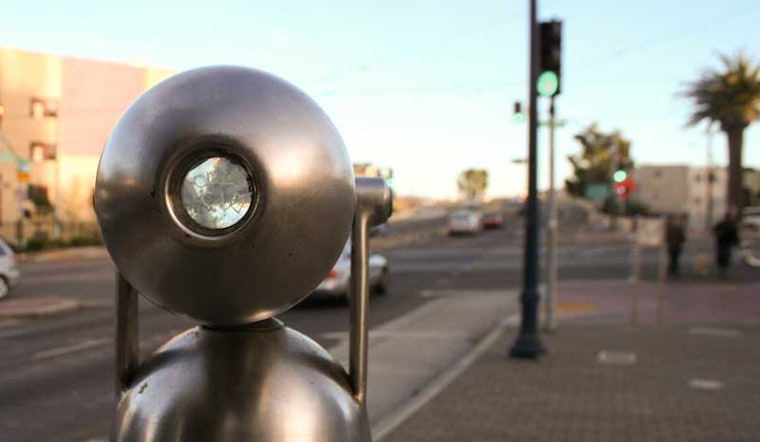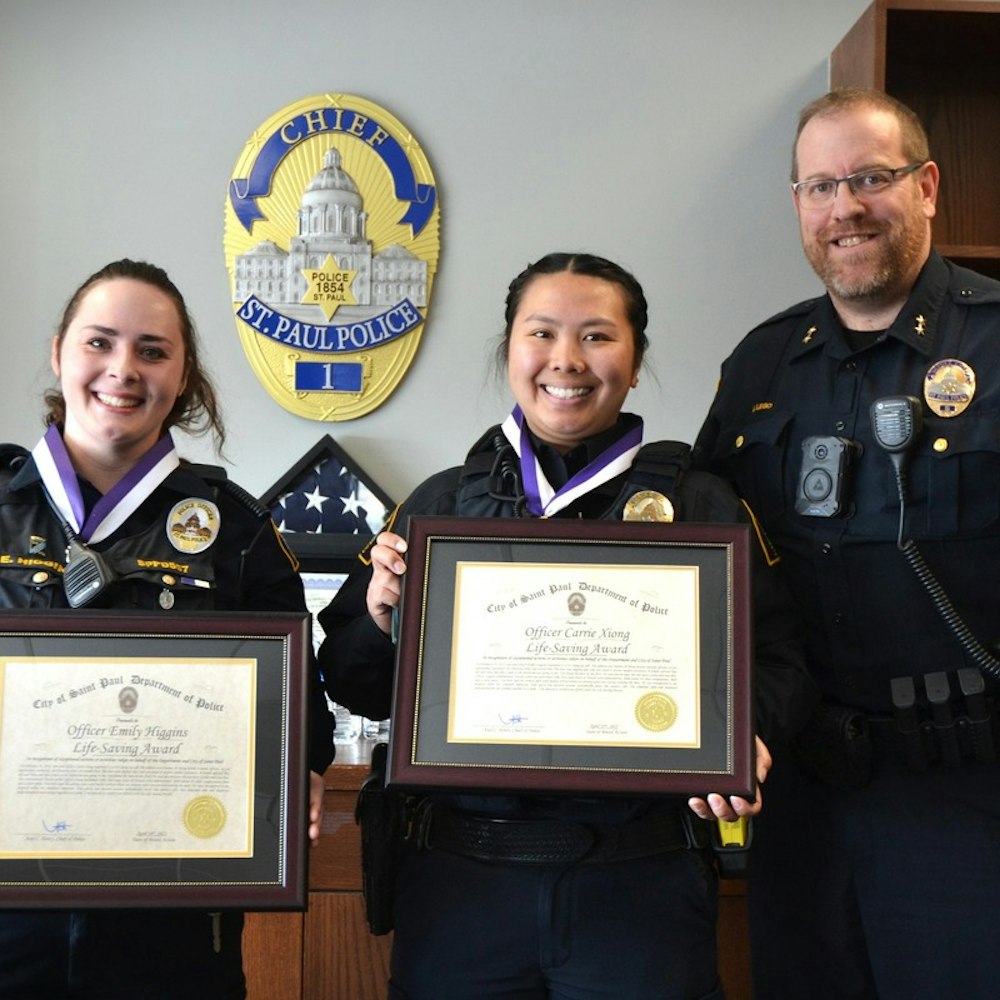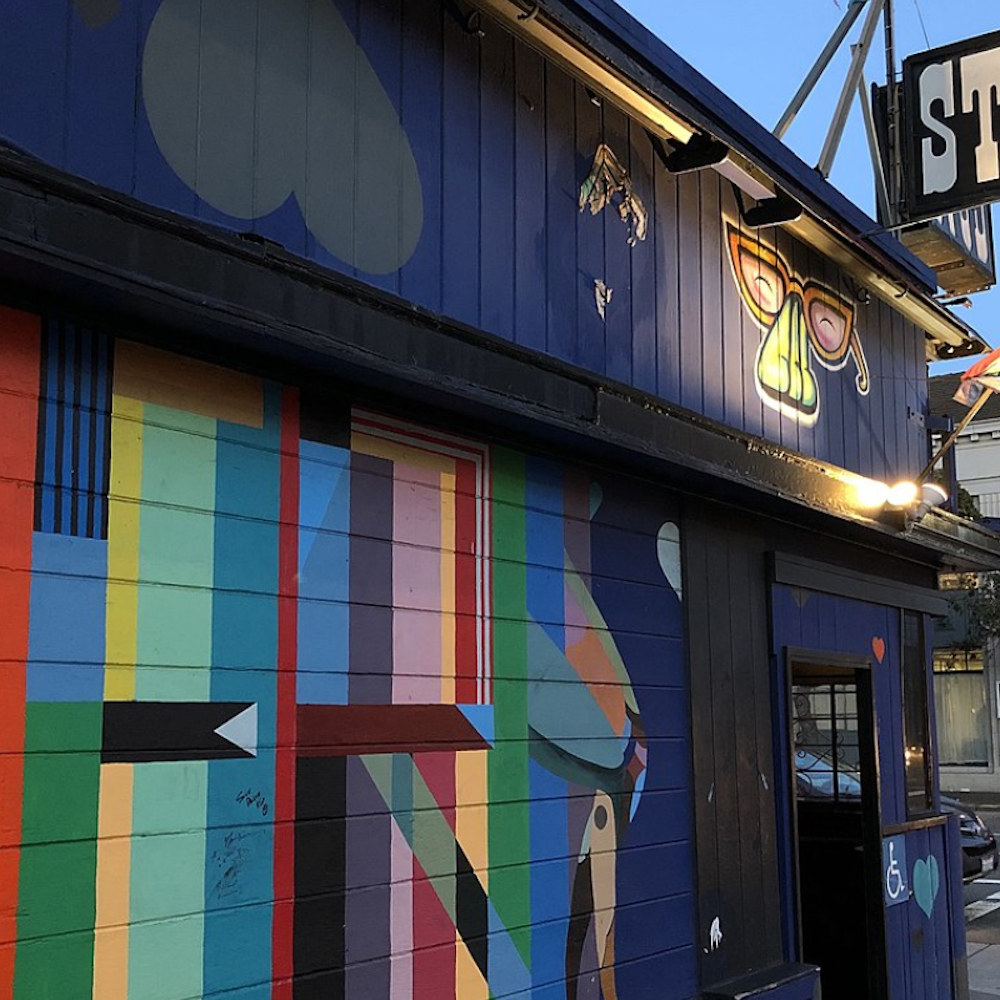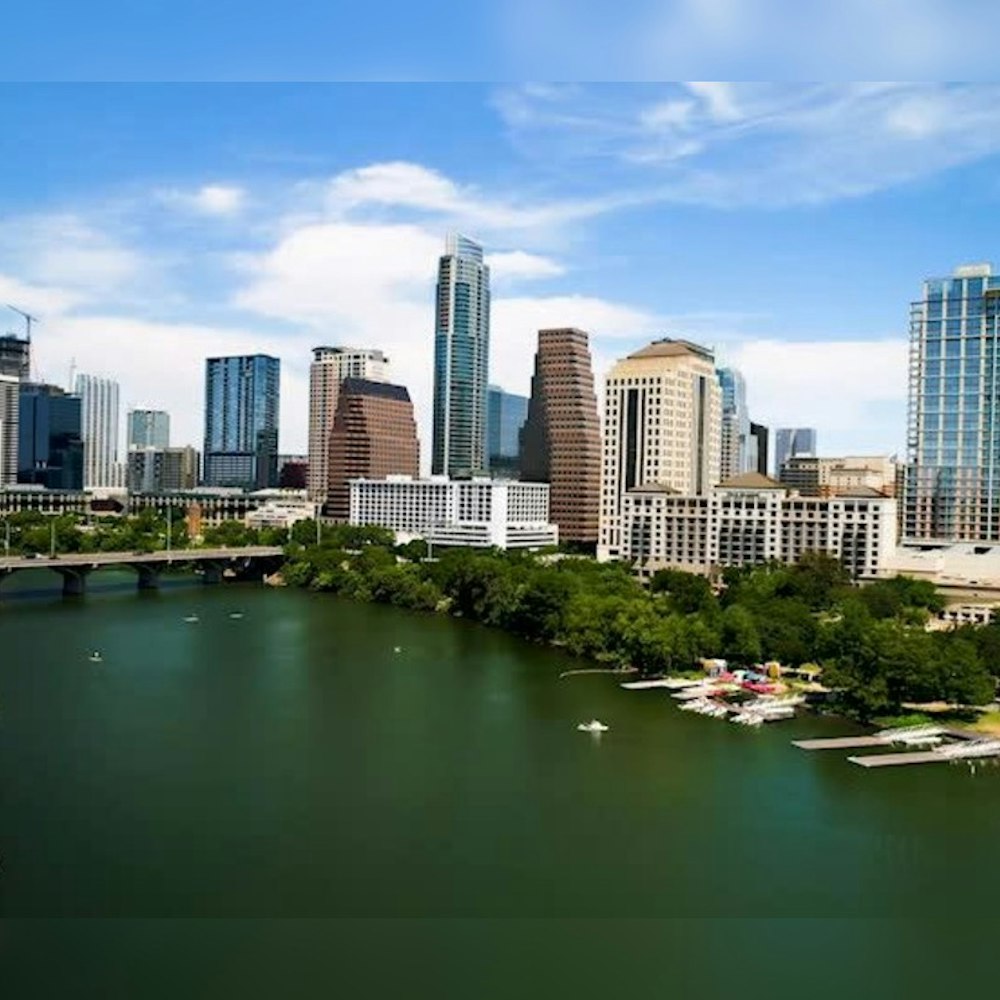
With all of the hustle and bustle along Octavia Boulevard, one might miss the subtle stainless steel telescopes planted within the median of the busy thoroughfare.
Twelve of these mini-observatories are erected at various intersections, from Octavia and Market to the middle of Patricia's Green. Each one has been specifically placed to offer a transformed perspective of the surrounding environment and the passing cars. This collection of kaleidoscopic lookouts by Bay Area-based artist Po Shu Wang are known as “Ghinlon/Transcope”, and they symbolize an important turning point in the history of Hayes Valley. The Quake Once upon a time, the Central Freeway was an elevated roadway that cut through Hayes Valley, creating urban blight in its shadow. As a result, our hood used to be one of the seedier parts of San Francisco. When the 1989 Loma Prieta earthquake struck with a magnitude of 6.9, the structural integrity of the throughway was comprised. In 1997, the northern part near Fell Street was torn down, and eventually the entire elevated expressway was removed. Out of destruction, though, came revitalization. Leveling Octavia to a street-grade traffic artery was key to transforming Hayes Valley into the neighborhood it is today. When the chunk of damaged freeway was removed, Octavia was exposed and enlivened. To commemorate this occasion, the San Francisco Arts Commission announced a contest, with the goal of commissioning public art to further beautify the space. In Comes Po Shu Among the many artists who competed was Hong Kong-born Po Shu Wang. He saw the unique challenge of embracing the new openness of the boulevard with the juxtaposition of pedestrians and the traffic passing through. “I used the traffic as a starting point," Po Shu said. "Instead of ignoring it, I wanted to see what I could do to turn it slightly into a beneficial feature of the street." Originally, Po Shu envisioned the construction of three large scale tuning forks that would be “tuned to the Sun, Earth, Moon's fundamental frequency periods of their free oscillations which are the Tonal Center pitches/notes of the three globes in musical terms,” he said. Using data from Stanford, NASA and the United States Geological Survey, the instruments would vibrate to the traffic, wind or even an earthquake, Po Shu told us. Two were to be placed at each end of Octavia and the third at the highest point of the boulevard. While the Arts Commission liked his idea, Po Shu noted that more experienced members of the board realized they would not have the budget to accomplish it. “They liked my thought process and vision for the street, so they told me they wanted to work with me,” Po Shu said. Po Shu went back to the drawing board, but this time he consulted with his longtime artistic partner, Louise Bertelsen, and the pair came up with the concept of constructing telescopes. However, there was just one teeny obstacle: neither of the pair had actually built a telescope before, let alone worked with mirrors and lenses. This didn't dampen their spirits or aspiration for the project, however. Given their history of creating grand site-specific installations that respond to environmental phenomena, they knew they would find a way to make it work. "We like to do artwork because of the joy we experience turning discovery into something tangible," Po Shu said. In the end, the telescopes were named the winner of the Arts Commission's contest by a panel of community members and art professionals. Building a Unique Perspective Over the next few years, the pair, (despite Louise's involvement not being official on paper), executed their vision with the help of a machinist. "The most difficult part of the process was the mechanical part, because we weren’t good with precision mechanics," Po Shu said. "We went back and forth with the machinist to see what could work." To test the different lenses and mirrors, they used cardboard tubes as stand-in telescopes to test how vehicular movements, shapes and lights would transform into extraordinary real time moving pictures. "I wanted to place [the transcopes] at each intersection, because [people who view them] are exposed and it's a reciprocal location," Po Shu told us, noting that pedestrians and commuters are both on display. Po Shu wanted to make these visual attractions available for everyone to utilize, so he made two standard designs: one for standing adults and one for person in wheelchairs and/or children. Additionally, the sculptures have a 60-degree vertical swing and a 180-degree horizontal swing to broaden the range of kaleidoscopic sight of each installment. After the dust cleared from the demolition and the installment finally opened in September 2005, Po Shu had the sculptures inscribed with his interpretation of the unique lens and mirror combination, in an effort to enlighten viewers on what they experience when looking through the glass onto the transformed landscape. So the next time you're on Octavia, took a look at -- and through -- the transcopes, and see if they don't change your view of this quickly-changing neighborhood. To follow Po Shu and Louise’s current adventures into site-specific art installations throughout the globe, visit their website.
Twelve of these mini-observatories are erected at various intersections, from Octavia and Market to the middle of Patricia's Green. Each one has been specifically placed to offer a transformed perspective of the surrounding environment and the passing cars. This collection of kaleidoscopic lookouts by Bay Area-based artist Po Shu Wang are known as “Ghinlon/Transcope”, and they symbolize an important turning point in the history of Hayes Valley. The Quake Once upon a time, the Central Freeway was an elevated roadway that cut through Hayes Valley, creating urban blight in its shadow. As a result, our hood used to be one of the seedier parts of San Francisco. When the 1989 Loma Prieta earthquake struck with a magnitude of 6.9, the structural integrity of the throughway was comprised. In 1997, the northern part near Fell Street was torn down, and eventually the entire elevated expressway was removed. Out of destruction, though, came revitalization. Leveling Octavia to a street-grade traffic artery was key to transforming Hayes Valley into the neighborhood it is today. When the chunk of damaged freeway was removed, Octavia was exposed and enlivened. To commemorate this occasion, the San Francisco Arts Commission announced a contest, with the goal of commissioning public art to further beautify the space. In Comes Po Shu Among the many artists who competed was Hong Kong-born Po Shu Wang. He saw the unique challenge of embracing the new openness of the boulevard with the juxtaposition of pedestrians and the traffic passing through. “I used the traffic as a starting point," Po Shu said. "Instead of ignoring it, I wanted to see what I could do to turn it slightly into a beneficial feature of the street." Originally, Po Shu envisioned the construction of three large scale tuning forks that would be “tuned to the Sun, Earth, Moon's fundamental frequency periods of their free oscillations which are the Tonal Center pitches/notes of the three globes in musical terms,” he said. Using data from Stanford, NASA and the United States Geological Survey, the instruments would vibrate to the traffic, wind or even an earthquake, Po Shu told us. Two were to be placed at each end of Octavia and the third at the highest point of the boulevard. While the Arts Commission liked his idea, Po Shu noted that more experienced members of the board realized they would not have the budget to accomplish it. “They liked my thought process and vision for the street, so they told me they wanted to work with me,” Po Shu said. Po Shu went back to the drawing board, but this time he consulted with his longtime artistic partner, Louise Bertelsen, and the pair came up with the concept of constructing telescopes. However, there was just one teeny obstacle: neither of the pair had actually built a telescope before, let alone worked with mirrors and lenses. This didn't dampen their spirits or aspiration for the project, however. Given their history of creating grand site-specific installations that respond to environmental phenomena, they knew they would find a way to make it work. "We like to do artwork because of the joy we experience turning discovery into something tangible," Po Shu said. In the end, the telescopes were named the winner of the Arts Commission's contest by a panel of community members and art professionals. Building a Unique Perspective Over the next few years, the pair, (despite Louise's involvement not being official on paper), executed their vision with the help of a machinist. "The most difficult part of the process was the mechanical part, because we weren’t good with precision mechanics," Po Shu said. "We went back and forth with the machinist to see what could work." To test the different lenses and mirrors, they used cardboard tubes as stand-in telescopes to test how vehicular movements, shapes and lights would transform into extraordinary real time moving pictures. "I wanted to place [the transcopes] at each intersection, because [people who view them] are exposed and it's a reciprocal location," Po Shu told us, noting that pedestrians and commuters are both on display. Po Shu wanted to make these visual attractions available for everyone to utilize, so he made two standard designs: one for standing adults and one for person in wheelchairs and/or children. Additionally, the sculptures have a 60-degree vertical swing and a 180-degree horizontal swing to broaden the range of kaleidoscopic sight of each installment. After the dust cleared from the demolition and the installment finally opened in September 2005, Po Shu had the sculptures inscribed with his interpretation of the unique lens and mirror combination, in an effort to enlighten viewers on what they experience when looking through the glass onto the transformed landscape. So the next time you're on Octavia, took a look at -- and through -- the transcopes, and see if they don't change your view of this quickly-changing neighborhood. To follow Po Shu and Louise’s current adventures into site-specific art installations throughout the globe, visit their website.









